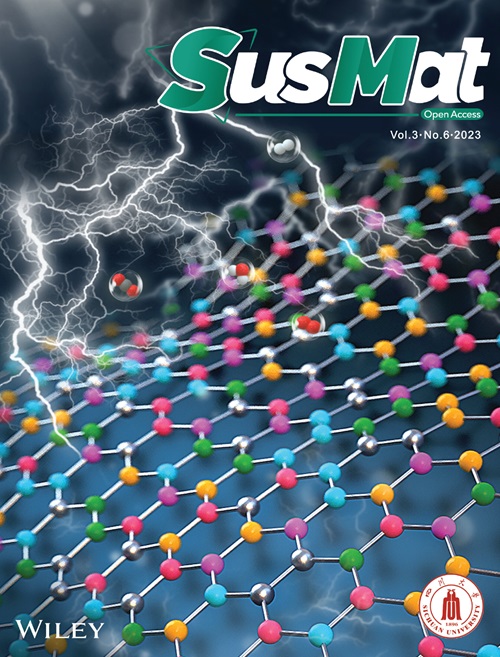Low dielectric constant and highly intrinsic thermal conductivity fluorine‐containing epoxy resins with ordered liquid crystal structures
IF 18.7
1区 材料科学
Q1 CHEMISTRY, MULTIDISCIPLINARY
引用次数: 0
Abstract
Epoxy resins with a high dielectric constant and low intrinsic thermal conductivity coefficient cannot meet the current application requirements of advanced electronic and electrical equipment. Therefore, novel fluorine‐containing liquid crystal epoxy compounds (TFSAEy) with fluorinated groups, biphenyl units, and flexible alkyl chains are first synthesized via amidation and esterification reactions. Then, 4,4′‐diaminodiphenylmethane (DDM) is used as a curing agent to prepare the corresponding fluorine‐containing liquid crystal epoxy resins. The obtained dielectric constant (ε) and dielectric loss (tan δ) values of TFSAEy/DDM at 1 MHz are 2.54 and 0.025, respectively, which are significantly lower than those of conventional epoxy resins (E‐51/DDM, 3.52 and 0.038). Additionally, the intrinsic thermal conductivity coefficient (λ) of TFSAEy/DDM is 0.36 W/(m·K), 71.4% higher than that of E‐51/DDM (0.21 W/(m·K)). Meanwhile, the corresponding elastic modulus, hardness, glass transition temperature, and heat resistance index of TFSAEy/DDM are 5.73 GPa, 0.35 GPa, 213.5°C, and 188.7°C, respectively, all superior to those of E‐51/DDM (3.68 GPa, 0.27 GPa, 107.2°C, and 174.8°C), presenting potential application in high‐heating electronic component packaging and printed circuit boards.具有有序液晶结构的低介电常数和高固有导热性含氟环氧树脂
高介电常数和低固有导热系数的环氧树脂不能满足当前先进电子电气设备的应用要求。因此,首先通过酰胺化和酯化反应合成了具有氟化基团、联苯单元和柔性烷基链的新型含氟液晶环氧化合物(TFSAEy)。然后以4,4′-二氨基二苯基甲烷(DDM)为固化剂制备相应的含氟液晶环氧树脂。在1 MHz频率下,TFSAEy/DDM的介电常数(ε)和介电损耗(tan δ)值分别为2.54和0.025,显著低于常规环氧树脂(E‐51/DDM、3.52和0.038)。此外,TFSAEy/DDM的固有导热系数λ为0.36 W/(m·K),比E‐51/DDM的0.21 W/(m·K)高71.4%。同时,TFSAEy/DDM的弹性模量、硬度、玻璃化转变温度和耐热指数分别为5.73 GPa、0.35 GPa、213.5℃和188.7℃,均优于E - 51/DDM (3.68 GPa、0.27 GPa、107.2℃和174.8℃),在高温电子元件封装和印刷电路板中具有潜在的应用前景。
本文章由计算机程序翻译,如有差异,请以英文原文为准。
求助全文
约1分钟内获得全文
求助全文
来源期刊
自引率
4.20%
发文量
0
期刊介绍:
SusMat aims to publish interdisciplinary and balanced research on sustainable development in various areas including materials science, engineering, chemistry, physics, and ecology. The journal focuses on sustainable materials and their impact on energy and the environment. The topics covered include environment-friendly materials, green catalysis, clean energy, and waste treatment and management. The readership includes materials scientists, engineers, chemists, physicists, energy and environment researchers, and policy makers. The journal is indexed in CAS, Current Contents, DOAJ, Science Citation Index Expanded, and Web of Science. The journal highly values innovative multidisciplinary research with wide impact.

 求助内容:
求助内容: 应助结果提醒方式:
应助结果提醒方式:


